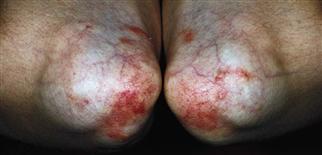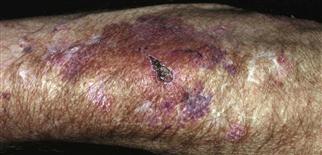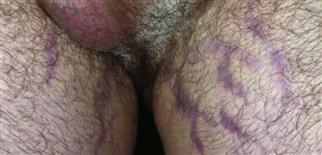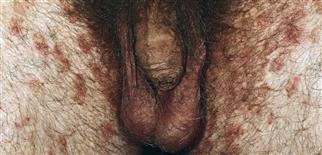1
Basic principles of
treatment

Steroid atrophy. Atrophy with prominence of the underlying veins and hypopigmentation after use of a superpotent steroid applied daily for 3 months to treat psoriasis.

Long-term use of topical corticosteroids can produce thinning of the skin, allowing easy bruising.

Striae of the groin after long-term use of group V topical steroids for pruritus. These changes are irreversible.

Inappropriate application of a topical steroid causes tinea cruris to flare (tinea incognito).
MAINTAINING THE SKIN BARRIER
• Functions of the skin: fluid homeostasis; protection from infection, toxin absorption, temperature regulation and ultraviolet radiation. • Primary goal of topical or systemic dermatologic therapy: restore and maintain a normal skin barrier.
SKIN CLEANSING
Use mild soaps and cleansers (Cetaphil, Dove, Keri, or Aveeno). Limit use of exfoliating brushes and fragranced soaps. Wash with tepid, not hot, water.
SKIN MOISTURIZATION
Moisturize immediately after washing. Use thicker, oil-based ointments for excessively dry, damaged skin. Use lotions to maintain healthy skin. Use exfoliating emollients containing glycolic acids (lactic acid, salicylic acid) and urea to gently remove scales. Examples of lubricating creams and lotions. • Thicker creams and ointments: Vaseline petroleum jelly, Aquaphor ointment, CeraVe. • Lighter creams: Acid Mantle, Cetaphil cream, DML cream, Moisturel cream, Vanicream. • Lighter lotions: Cetaphil lotion, DML lotion, Nutraderm lotion, Curél lotion, Aveeno lotion, CeraVe lotion.
TOPICAL FORMULATIONS
Two main factors determine the effectiveness of a topical medication: the drug and the vehicle (base). Vehicles assist in drug delivery and have therapeutic properties. • Vehicle examples: powders (drying), ointments (moisturizing, form protective barrier, increase skin penetration of drug), creams (cooling, not occlusive), pastes (drying, less greasy), solutions or lotions (drying, effective for hairy areas), gels or foams (greaseless).
TOPICAL APPLICATION AND DOSING
Gently massage medication into skin in one thin layer. No need for thick application: 1 g of cream covers a 10 × 10-cm area. The amount of cream applied to the finger from the distal skin crease to the tip of an adult index finger is 0.5 g. Apply creams once or twice a day. Skin location affects ease of medication penetration. The following anatomic locations are organized in increasing difficulty of medication penetration: mucous membranes (easy penetration) > scrotum > eyelids > face > torso > extremities > palms and soles.
WET DRESSINGS
Useful to dry exudative (wet) skin diseases or debride infected wounds. • Immerse a clean, soft cloth (such as bed sheeting or shirt material slightly larger than the treated area) in cool (antiinflammatory) or tepid solution (e.g. tepid water, Burow’s solution). • Gently wring out excess solution and apply wet cloth to skin. • Leave dressing open to air and in place for 30 min. • Repeat 2−4 times a day. • Discontinue when skin becomes dry.







